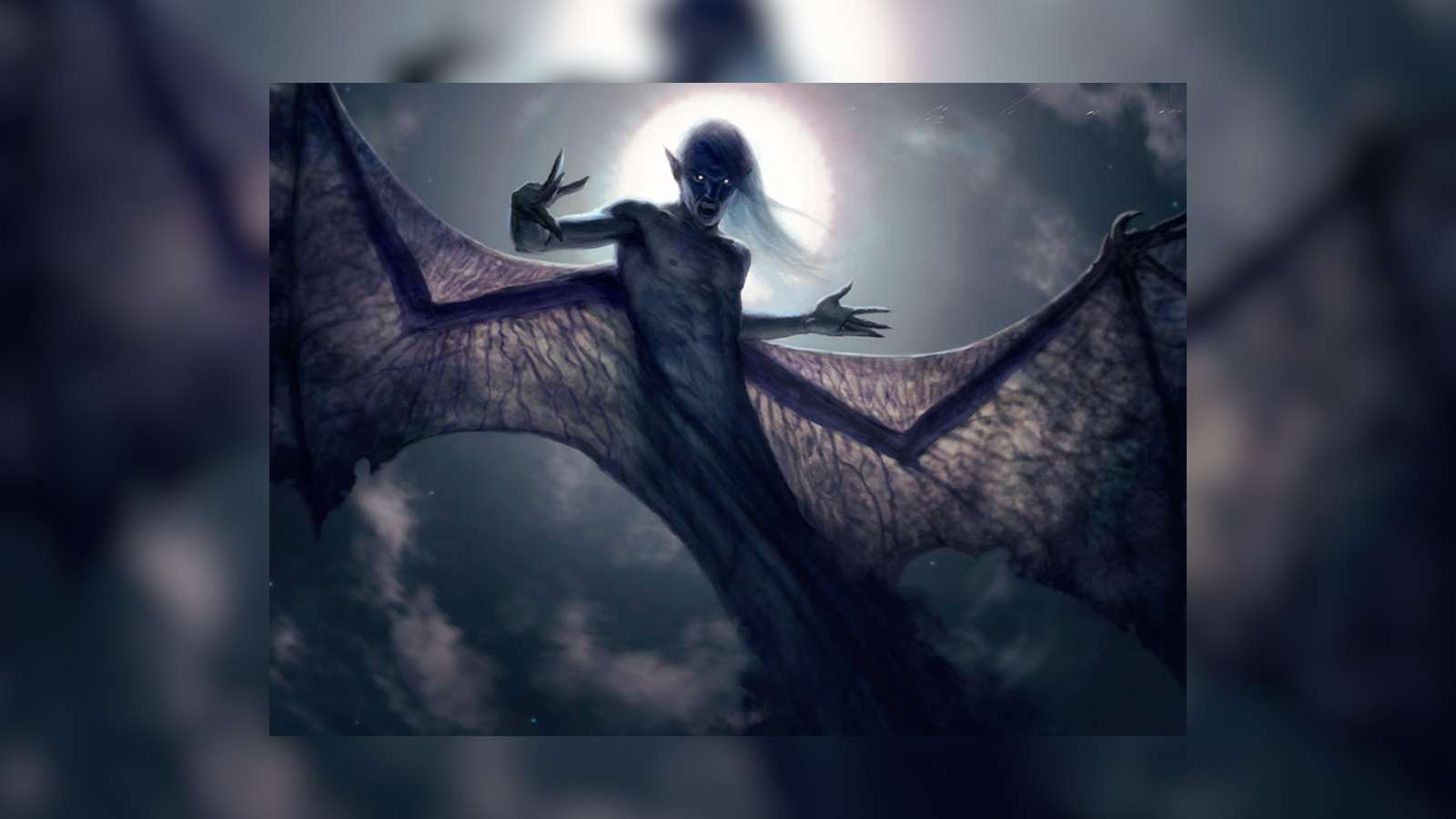While horror is a truly popular genre around the entire world, part of its strength and fun come from incorporating local folklore and presenting those to a global audience. Think about the Romanian Strigoi for example, an inspiration for Bram Stoker’s Dracula. Or the Japanese vengeful ghost Onryō: who doesn’t like those creepy long-haired japanese girls with an intense stare? A very interesting and for us rather unknown creature originating from the Philippines is the Aswang. And while Filipino culture has a vast lore of monsters, the macabre and grim Aswang creature is without a doubt the most frequent and infamous one.
A modern Western depiction of the creature in popular culture can be found in a modern TV-series of the Aswang, Grimm. The episode “Mommy Dearest” (Season 3, Episode 13) features one in all of its fluid- and life-sucking glory. Let’s have a closer look at this strange beast.
[image lightbox=”1″ caption=”Art by Anthony Francisco”]https://www.scarystudies.com/wp-content/uploads/2021/02/aswang-grimm-2-1.jpg[/image]There is no clear fixed definition of what an Aswang is. The word comes from the Sanskrit language “asura”, which means ‘demon’. Another name for (some?) Aswang is Tik-Tik, named after the ticking sound the creature produces. This is clearly featured in the episode of Grimm, where an Aswang clicks his menacing tongue.
“Depending on what you read, an Awang could be similar to a vampire or werewolf of our Western culture, in that it is a shapeshifter, can change from a beautiful woman to a creature with a blood sucking proboscis or even a dog or some other kind of animal,” says writer T.G. Arsenault in an exclusive interview with Scary Studies. Arsenault was one of the first American authors to feature an Aswang in his horror novel ‘Bleeding The Vein’ from 2012.
So ‘Aswang’ should be seen more as a generic term, featuring different kinds of regional variants and different subspecies. However, according to the website ‘Aswang Project’ there are three main characteristics: 1) an Aswang eats human liver and blood, 2) with a preference for unborn children, and 3) also it likes to prey on the sick and young.
During daytime an Aswang looks like a normal person, but at night its appearance changes as it goes hunting for flesh. “There are other variations, but I think the overall theme is the same: sucking and living on the blood, or life, or essence of other beings, usually preying at night,” according to Arsenault.
Filippino Flying Succubus
One of those interesting variations or subspecies of an Aswang is the female Manananggal. By day she is a seemingly beautiful attractive woman, but at night she transforms into her true self. She separates her body in half and sprouts large wings. So, remember: the next time you see a demonic female flying around without any legs you know it’s not your mother-in-law but a Manananggal (sorry, Lisa, just kidding…).
— FOUNDATIONS OF HORROR —
Further explore these subgenres & tropes. more>>
#Folk horror | #Capital M Monsters

Because of her feminine lure this creature bears some similarities to a western succubus, which Arsenault effectively used in his novel. ‘Bleeding The Vein’ tells the story of retired Navy Officer Eddie Townsend who in his Navy days met a Manananggal in a Filippino strip bar and was seduced by her. Now living a secluded alcohol-addicted life in a small American town, he finds that something sinister has come back and start stalking the local community.
“I used the Aswang as a mirror of my main character’s other demon, alcohol, which was mostly caused by the former, and created his demise from society. Two conflicts he has to overcome,”explains Arsenault.
How did he discover these creatures from Filipino folkore? “I first learned of the Aswang from my ex-wife. Her mom was a Filipino married to a U.S. serviceman. The legend always interested me since we weren’t very familiar with it in the United States (as far as I knew) with this legend, though it took me years to finally sit down and write about it, where most my own research is what I used for the novel, taking liberties of the legend to tailor it to my own story.
“A few pieces from my research that I used in the novel is the ability to detect an Aswang in the reflection of yourself in someone’s eyes, (which would appear inverted). Another was the ability of the Aswang (when she goes to feed) to separate and leave her lower torso behind, basically flying with a lovely set of entrails in tow. And the third piece was using salt as a way to counteract its abilities. There are other countermeasures, but salt worked well with what I wanted to do. I think I read somewhere that some Filipinos place salt near windows or entryways to stop the entry of an Aswang.”
It is clear that Filipino culture is deeply ingrained with stories and beliefs of monsters. But why is this so?
Real life Aswang
There are several possible explanations for the dominance of the Aswang myth. Some point to the Spanish colonization, where Christianity forced the local ‘old beliefs’ to retreat to the underground. This has caused these beliefs to become firmly fixed in the collective Filipino unconscious. Others refer to the exotic local wildlife: bats and the local flying lemur or kagwang have often been killed because they were presumed to be Aswang flying around.
There is another fascinating theory about its origins. XDP or X-linked dystonia-parkinsonism is a degenerative genetic disease, giving patients a movement disorder (dystonia) with symptoms such as tremor and rigidity. It is a disease which exclusively affects males, who are almost entirely of Filipino descent. But the regional origins of XDP go even further: 93% of all current XDP patients are found in one of the islands of the Philippines, Panay Island. And 63% or the XDP cases are based in the province of Capiz. And while the folklore of the Aswang is something that can be found everywhere in the Philippines, it is especially present in Capiz, with many Filipinos pointing to this province as the home and origin of the Aswang. It is not difficult to imagine why a patient with XDP could have been viewed in earlier times as something that is about to transform: convulsing, twisting, and shaking in strange and fearful ways.
This has been examined thoroughly by journalist and filmmaker Jordan Clark, who produced the feature documentary The Aswang Phenomenon in 2011, an ‘exploration of the aswang folklore and its effects on Philippine society’. It was later further expanded into a webseries about other ‘Creatures of Philippine Mythology’. This is all collected in the website ‘Aswang Project’, your go-to site to explore the rich and wonderful world of Filipino myths and monsters.
[image lightbox=”1″ caption=”Grimm, NBC”]https://www.scarystudies.com/wp-content/uploads/2021/02/aswang-grimm-3-1.png[/image]Grim Inspiration
This rich mythology can offer a lot of inspiration for horror creators who are looking for a new and interesting creature. And this is exactly what T.G. Arsenault did: “I found a nugget of information among the different variations of the legend and attempted to make it available to readers in a way I understood it in my mind. Probably, for most readers of my novel, “Bleeding the Vein,” wouldn’t know of the creature, so I kind of felt like I had free reign in how I wrote the story, since there most likely weren’t any presumed expectations. Its origin is not as well-known in the west, which is kind of why I wanted to write a story about it, something different. I thought it was a great way to tackle a similar trope in a different way. As a new writer still trying to establish a reader base, I wanted to write a story that was a bit unique and interesting and hope I did so in my novel.”
You sure did, T.G.!
“Bleeding the Vein” as well as his first novel, Forgotten Souls, are set to reprint this year at publishing house Crossroad Press: https://crossroadpress.com
Art by thienbao on DevientArt.
Last Updated on March 24, 2021.

